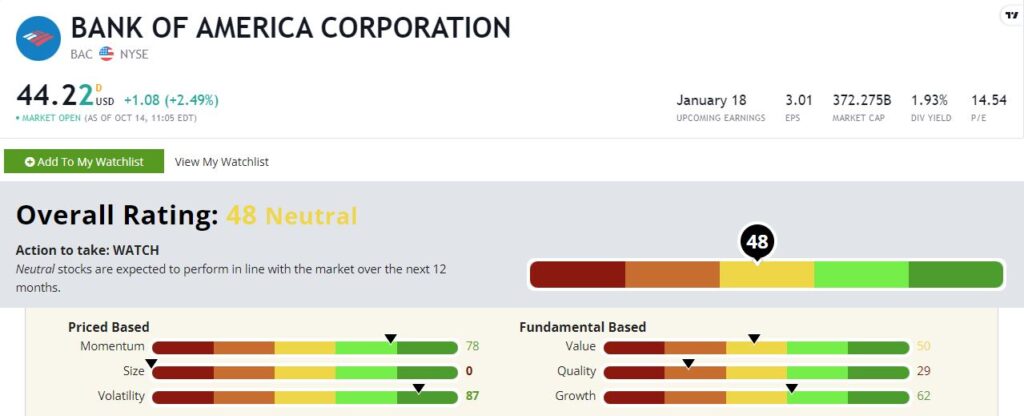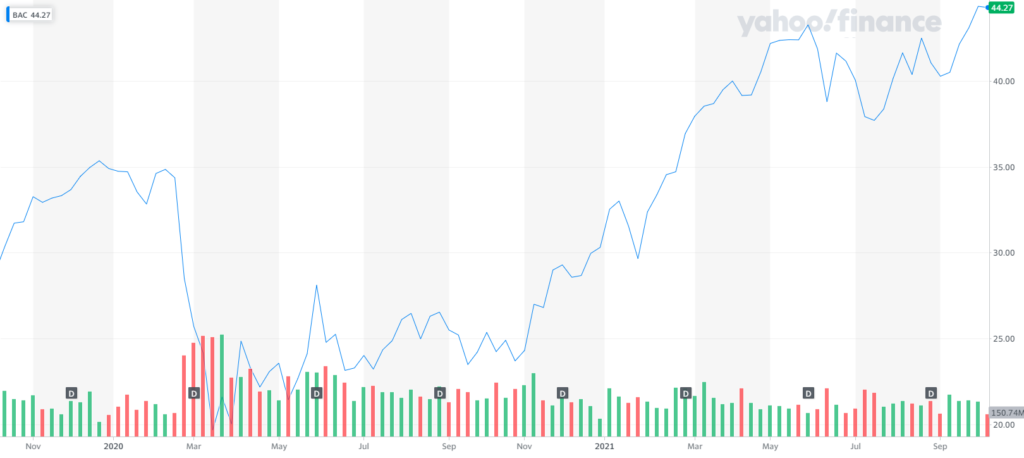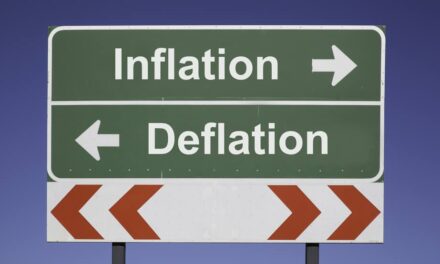Headlines drive financial markets.
For better or worse, investors react to news that crosses their feeds, sending stocks and broader sectors higher or lower.
Top market trends are hidden within these headlines. It’s just a matter of knowing how to play them. Don’t worry! The Money & Markets team has you covered.
Each week, I’ll highlight a top market headline that crossed my feed. I’ll tell you why these headlines matter and how we’re playing them.
Let’s get started!
Earnings Season Kickoff
Big banks wowed to kick off the latest earnings season on Thursday, sparking headlines such as:
- “The big banks are bullish about the recovery.”
- “Jim Cramer reacts to big bank earnings: I am blown away.”
- “The Pandemic’s Over for Big Banks. Now Comes the Hard Part.”
Bank of America Corp. (NYSE: BAC) walloped earnings estimates, reporting earnings per share growth of $0.85 per share, a full 14 cents over analysts’ estimates.
It also reported beat on revenue, reporting $22.87 billion for the third quarter of 2021. Analysts set the bar at $21.8 billion.
The earnings beat was enough to send BAC shares 4.5% higher on Thursday.
Morgan Stanley (NYSE: MS), Citigroup Inc. (NYSE: C) and Wells Fargo & Co. (NYSE: WFC) also managed to beat expectations, setting a positive tone for a much-anticipated earnings season.
Green Zone Rating: Bank of America Corp. (NYSE: BAC)
I had to look up BAC in Adam O’Dell’s proprietary Green Zone Ratings system after its blockbuster earnings call.
Adam built this model to rate stocks on the six factors proven to drive market-beating returns. (Read more about the six factors at the end of this story.)
Our team runs this model daily on a universe of more than 8,000 stocks and rank based on “Overall Rating.” These ratings range from 0 to 100, where 0 is “worst,” and 100 is “best.”
And best of all? It’s on our website! Feel free to use it to look up any stocks on your radar. Read our handy guide here to get started now.

Bank of America Corp.’s Green Zone Rating on October 14, 2021.
Its 48 rating is enough to put Bank of America stock in the “Neutral” category. That means we can expect BAC to perform in line with the overall market over the next 12 months.
A neutral rating doesn’t wow me, but I want to focus on its “Bullish” ratings in the individual factors.
Bank of America stock’s volatility score is an impressive 87. That means BAC is less volatile than all but 13% of 8,000 stocks that we rate.
Pair that with a momentum score of 78, and you’ve got a stock that is going up at a steady pace. You can see BAC’s price movement over the last two years in the chart below.
BAC Earns High Momentum Score

Source: Yahoo Finance.
Stock market indexes have been choppy over the last month and a half. But BAC has managed to gain 12% since its recent low on September 21.
We’ll have to see if BAC can ride its post-earnings pop higher, but this is a stock to have on your radar beyond this earnings season.
And if you’re looking for more plays within the financial sector after big bank earnings, you need to check out Adam’s premium stock research service, Green Zone Fortunes. Adam recommended two stocks within the broader financial world:
- A community bank stock with a near-perfect 98 Green Zone Rating. Its earnings call next week could be the catalyst for a 50% run higher over the next 12 to 18 months.
- A brokerage (not Robinhood!) with massive growth potential. It has increased its net income by more than 130% in the last year alone!
Click here to see how you can join Adam in Green Zone Fortunes. You’ll also find out all about Adam’s No. 1 stock mega trend of this decade, “Imperium.”
Green Zone Ratings Factors
Momentum — Strongly uptrending stocks earn higher momentum ratings. We prefer to buy stocks that are already trending higher and at a faster rate than the overall market. This approach can increase our odds of success and decrease risk.
Value — Less expensive (aka “cheap”) stocks earn higher value ratings. We prefer to buy great companies at good prices because the price we pay impacts future returns. Overpaying for a stock can be a costly mistake.
Quality — High-quality companies earn higher quality ratings. We prefer to buy high-quality companies, of course! To determine quality, the model considers a company’s returns, profit margins, cash flows, debt ratios and operational efficiency, among other things.
Growth — High-growth companies earn higher growth ratings. All things equal, we prefer to buy companies that are growing both revenues and earnings at faster rates than the market and economy.
Size — Smaller companies earn higher size ratings. We prefer to buy smaller companies for the extra “juice” that typically comes with them.
Volatility — Less volatile stocks earn higher volatility ratings. We prefer low-volatility stocks because they’re proven to generate superior risk-adjusted returns over the long run — with less heartburn.
Best investing,

Chad Stone
Assistant Managing Editor, Money & Markets




